traction control CADILLAC DTS 2006 1.G Owners Manual
[x] Cancel search | Manufacturer: CADILLAC, Model Year: 2006, Model line: DTS, Model: CADILLAC DTS 2006 1.GPages: 450, PDF Size: 2.55 MB
Page 134 of 450
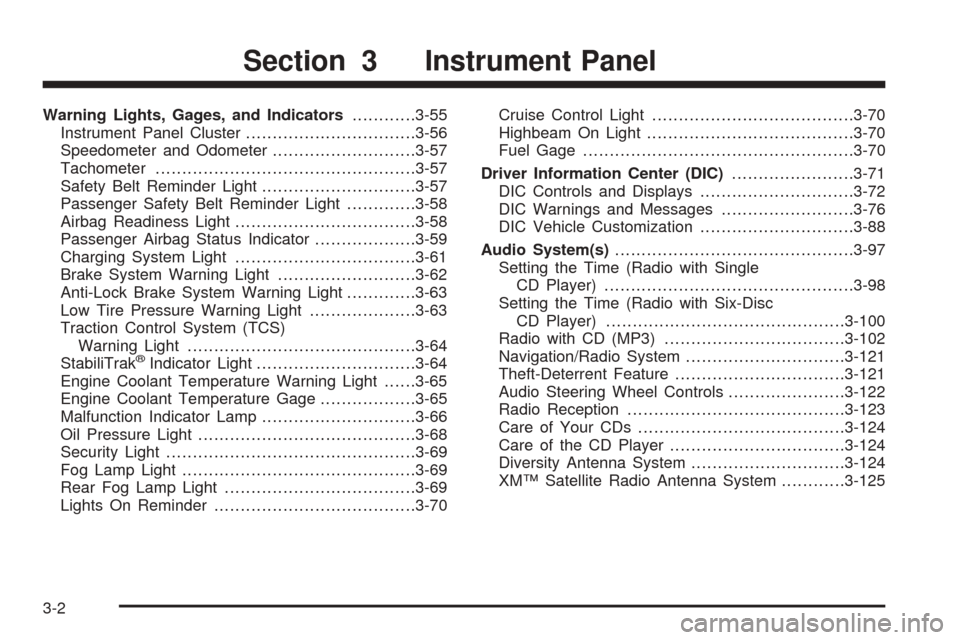
Warning Lights, Gages, and Indicators............3-55
Instrument Panel Cluster................................3-56
Speedometer and Odometer...........................3-57
Tachometer.................................................3-57
Safety Belt Reminder Light.............................3-57
Passenger Safety Belt Reminder Light.............3-58
Airbag Readiness Light..................................3-58
Passenger Airbag Status Indicator...................3-59
Charging System Light..................................3-61
Brake System Warning Light..........................3-62
Anti-Lock Brake System Warning Light.............3-63
Low Tire Pressure Warning Light....................3-63
Traction Control System (TCS)
Warning Light...........................................3-64
StabiliTrak
®Indicator Light..............................3-64
Engine Coolant Temperature Warning Light......3-65
Engine Coolant Temperature Gage..................3-65
Malfunction Indicator Lamp.............................3-66
Oil Pressure Light.........................................3-68
Security Light...............................................3-69
Fog Lamp Light............................................3-69
Rear Fog Lamp Light....................................3-69
Lights On Reminder......................................3-70Cruise Control Light......................................3-70
Highbeam On Light.......................................3-70
Fuel Gage...................................................3-70
Driver Information Center (DIC).......................3-71
DIC Controls and Displays.............................3-72
DIC Warnings and Messages.........................3-76
DIC Vehicle Customization.............................3-88
Audio System(s).............................................3-97
Setting the Time (Radio with Single
CD Player)...............................................3-98
Setting the Time (Radio with Six-Disc
CD Player).............................................3-100
Radio with CD (MP3)..................................3-102
Navigation/Radio System..............................3-121
Theft-Deterrent Feature................................3-121
Audio Steering Wheel Controls......................3-122
Radio Reception.........................................3-123
Care of Your CDs.......................................3-124
Care of the CD Player.................................3-124
Diversity Antenna System.............................3-124
XM™ Satellite Radio Antenna System............3-125
Section 3 Instrument Panel
3-2
Page 137 of 450
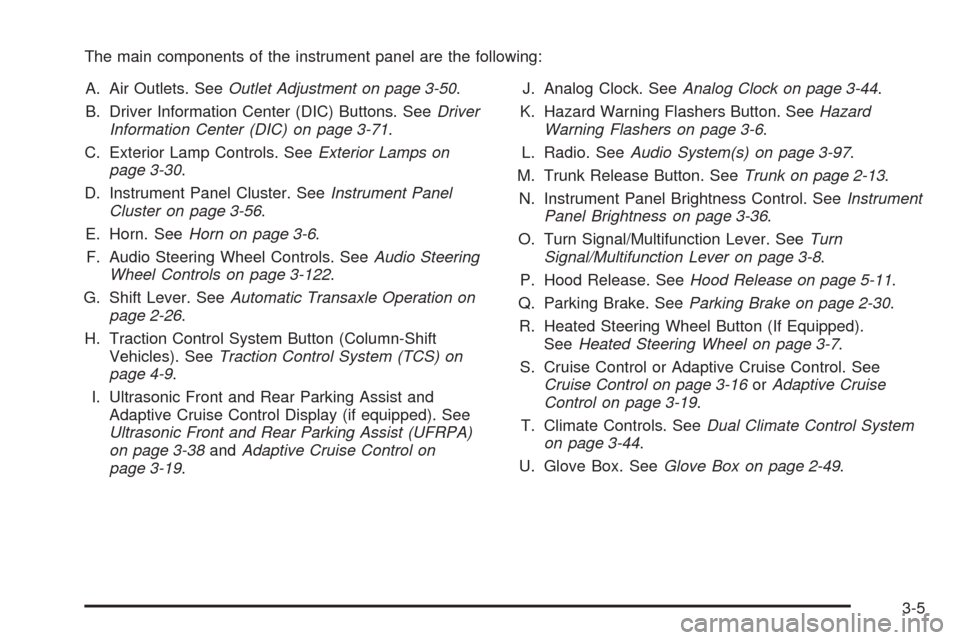
The main components of the instrument panel are the following:
A. Air Outlets. SeeOutlet Adjustment on page 3-50.
B. Driver Information Center (DIC) Buttons. SeeDriver
Information Center (DIC) on page 3-71.
C. Exterior Lamp Controls. SeeExterior Lamps on
page 3-30.
D. Instrument Panel Cluster. SeeInstrument Panel
Cluster on page 3-56.
E. Horn. SeeHorn on page 3-6.
F. Audio Steering Wheel Controls. SeeAudio Steering
Wheel Controls on page 3-122.
G. Shift Lever. SeeAutomatic Transaxle Operation on
page 2-26.
H. Traction Control System Button (Column-Shift
Vehicles). SeeTraction Control System (TCS) on
page 4-9.
I. Ultrasonic Front and Rear Parking Assist and
Adaptive Cruise Control Display (if equipped). See
Ultrasonic Front and Rear Parking Assist (UFRPA)
on page 3-38andAdaptive Cruise Control on
page 3-19.J. Analog Clock. SeeAnalog Clock on page 3-44.
K. Hazard Warning Flashers Button. SeeHazard
Warning Flashers on page 3-6.
L. Radio. SeeAudio System(s) on page 3-97.
M. Trunk Release Button. SeeTrunk on page 2-13.
N. Instrument Panel Brightness Control. SeeInstrument
Panel Brightness on page 3-36.
O. Turn Signal/Multifunction Lever. SeeTurn
Signal/Multifunction Lever on page 3-8.
P. Hood Release. SeeHood Release on page 5-11.
Q. Parking Brake. SeeParking Brake on page 2-30.
R. Heated Steering Wheel Button (If Equipped).
SeeHeated Steering Wheel on page 3-7.
S. Cruise Control or Adaptive Cruise Control. See
Cruise Control on page 3-16orAdaptive Cruise
Control on page 3-19.
T. Climate Controls. SeeDual Climate Control System
on page 3-44.
U. Glove Box. SeeGlove Box on page 2-49.
3-5
Page 148 of 450
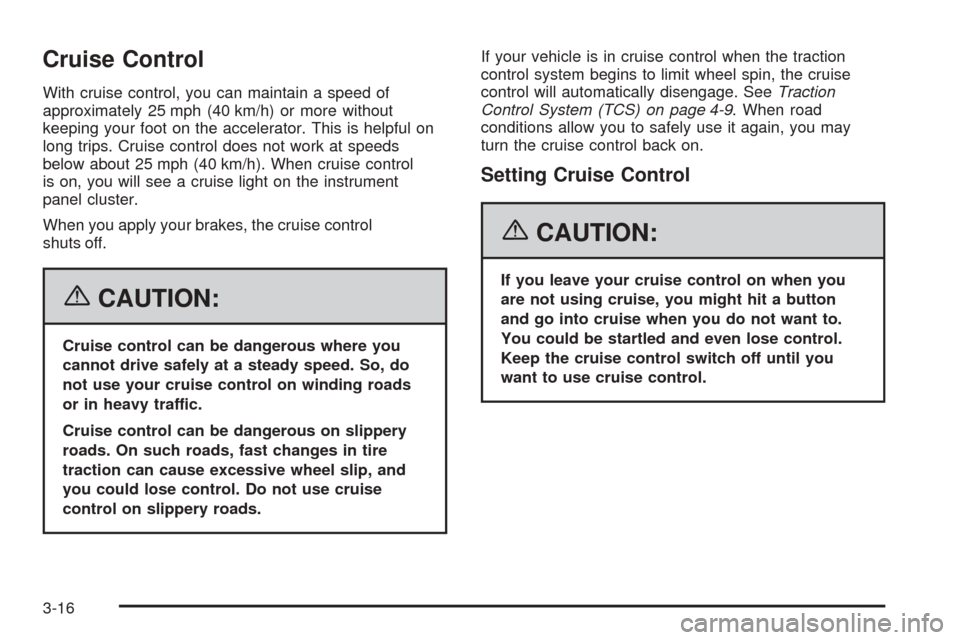
Cruise Control
With cruise control, you can maintain a speed of
approximately 25 mph (40 km/h) or more without
keeping your foot on the accelerator. This is helpful on
long trips. Cruise control does not work at speeds
below about 25 mph (40 km/h). When cruise control
is on, you will see a cruise light on the instrument
panel cluster.
When you apply your brakes, the cruise control
shuts off.
{CAUTION:
Cruise control can be dangerous where you
cannot drive safely at a steady speed. So, do
not use your cruise control on winding roads
or in heavy traffic.
Cruise control can be dangerous on slippery
roads. On such roads, fast changes in tire
traction can cause excessive wheel slip, and
you could lose control. Do not use cruise
control on slippery roads.If your vehicle is in cruise control when the traction
control system begins to limit wheel spin, the cruise
control will automatically disengage. SeeTraction
Control System (TCS) on page 4-9. When road
conditions allow you to safely use it again, you may
turn the cruise control back on.
Setting Cruise Control
{CAUTION:
If you leave your cruise control on when you
are not using cruise, you might hit a button
and go into cruise when you do not want to.
You could be startled and even lose control.
Keep the cruise control switch off until you
want to use cruise control.
3-16
Page 153 of 450
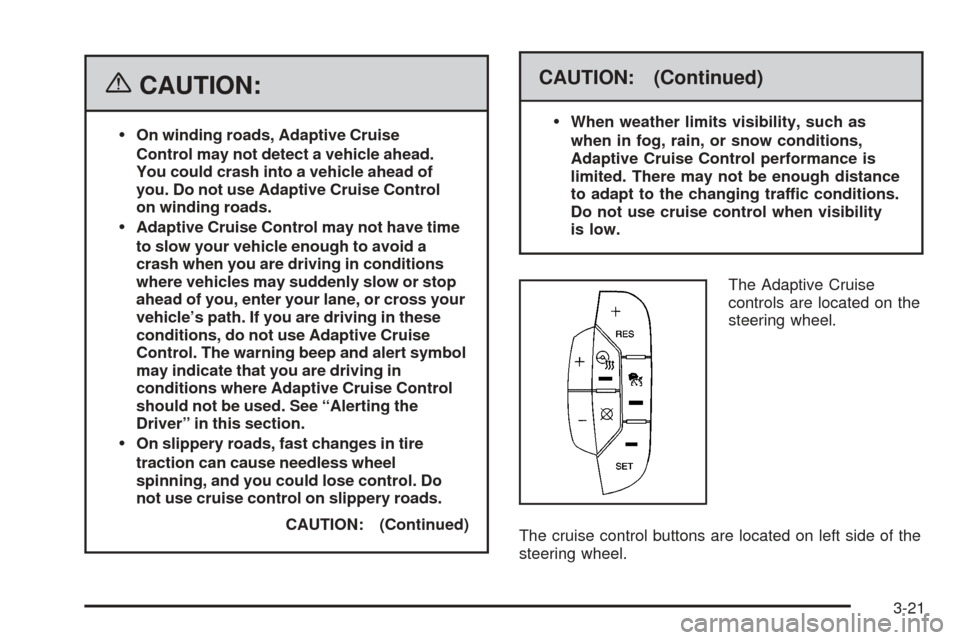
{CAUTION:
On winding roads, Adaptive Cruise
Control may not detect a vehicle ahead.
You could crash into a vehicle ahead of
you. Do not use Adaptive Cruise Control
on winding roads.
Adaptive Cruise Control may not have time
to slow your vehicle enough to avoid a
crash when you are driving in conditions
where vehicles may suddenly slow or stop
ahead of you, enter your lane, or cross your
vehicle’s path. If you are driving in these
conditions, do not use Adaptive Cruise
Control. The warning beep and alert symbol
may indicate that you are driving in
conditions where Adaptive Cruise Control
should not be used. See “Alerting the
Driver” in this section.
On slippery roads, fast changes in tire
traction can cause needless wheel
spinning, and you could lose control. Do
not use cruise control on slippery roads.
CAUTION: (Continued)
CAUTION: (Continued)
When weather limits visibility, such as
when in fog, rain, or snow conditions,
Adaptive Cruise Control performance is
limited. There may not be enough distance
to adapt to the changing traffic conditions.
Do not use cruise control when visibility
is low.
The Adaptive Cruise
controls are located on the
steering wheel.
The cruise control buttons are located on left side of the
steering wheel.
3-21
Page 155 of 450
 button.
2. Get up to the speed you want.
3. Press in the−SET button and release it.
4. Take your foot off the accelerator pedal.
CADILLAC DTS 2006 1.G Owners Manual To set Adaptive Cruise Control, do the following:
1. Press the
](On) button.
2. Get up to the speed you want.
3. Press in the−SET button and release it.
4. Take your foot off the accelerator pedal.](/img/23/7890/w960_7890-154.png)
To set Adaptive Cruise Control, do the following:
1. Press the
](On) button.
2. Get up to the speed you want.
3. Press in the−SET button and release it.
4. Take your foot off the accelerator pedal.
Once Adaptive Cruise Control is set, it may immediately
apply the brakes if it detects a vehicle ahead is too
close or moving slower than your vehicle.
The on symbol is located on the display at the top of
the instrument panel to the right of the driver. When
the on symbol is lit on the display, it indicates that
Adaptive Cruise Control is active.
A message on the DIC will also display when Adaptive
Cruise Control is set. SeeDIC Warnings and
Messages on page 3-76.
Keep in mind speed limits, surrounding traffic speeds,
and weather conditions when adjusting your set speed.
If your vehicle is in Adaptive Cruise Control when the
traction control system begins to limit wheel spin, the
Adaptive Cruise Control will automatically disengage.
SeeTraction Control System (TCS) on page 4-9and
StabiliTrak
®System on page 4-10. When road conditions
allow you to safely use it again, you may turn the
Adaptive Cruise Control back on.
Increasing Set Speed While Using Adaptive
Cruise Control
There are two ways to increase the set speed:
Use the accelerator to get to the higher speed.
Press the SET button and then release the
button and the accelerator pedal. You will now
cruise at the higher speed.
Press the RES button. Hold it there until the desired
set speed is displayed on the Driver Information
Center (DIC), then release the switch. To increase
your set speed in very small amounts, move the
switch brie�y to RES. Each time you do this,
your vehicle set speed will increase by
1 mph (1 km/h).
Your vehicle will not reach the set speed until the
system determines there is not a vehicle in front of you.
At that point, your vehicle speed will increase to the
set speed.
3-23
Page 196 of 450
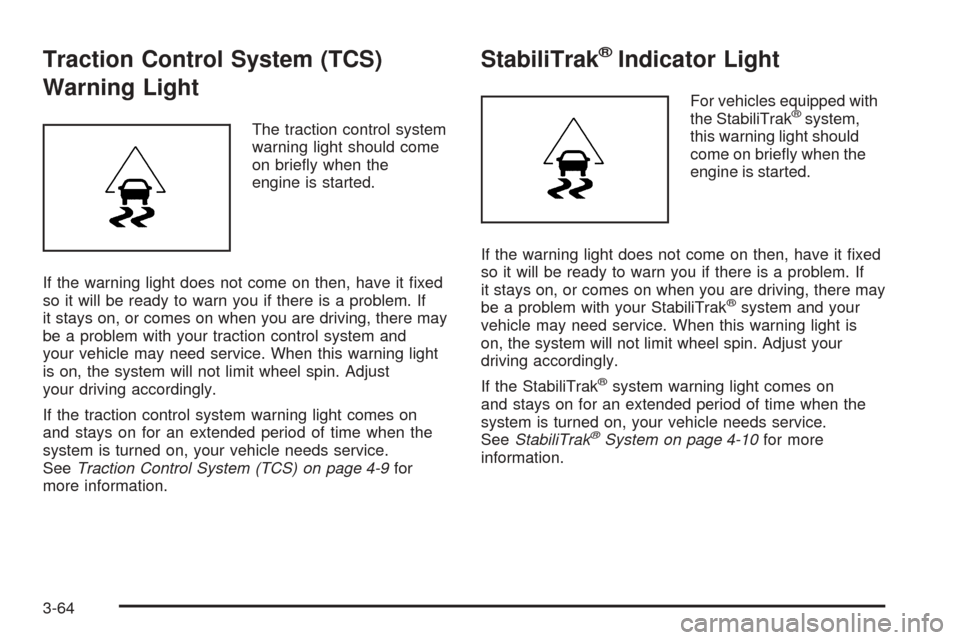
Traction Control System (TCS)
Warning Light
The traction control system
warning light should come
on brie�y when the
engine is started.
If the warning light does not come on then, have it �xed
so it will be ready to warn you if there is a problem. If
it stays on, or comes on when you are driving, there may
be a problem with your traction control system and
your vehicle may need service. When this warning light
is on, the system will not limit wheel spin. Adjust
your driving accordingly.
If the traction control system warning light comes on
and stays on for an extended period of time when the
system is turned on, your vehicle needs service.
SeeTraction Control System (TCS) on page 4-9for
more information.
StabiliTrak®Indicator Light
For vehicles equipped with
the StabiliTrak®system,
this warning light should
come on brie�y when the
engine is started.
If the warning light does not come on then, have it �xed
so it will be ready to warn you if there is a problem. If
it stays on, or comes on when you are driving, there may
be a problem with your StabiliTrak
®system and your
vehicle may need service. When this warning light is
on, the system will not limit wheel spin. Adjust your
driving accordingly.
If the StabiliTrak
®system warning light comes on
and stays on for an extended period of time when the
system is turned on, your vehicle needs service.
SeeStabiliTrak
®System on page 4-10for more
information.
3-64
Page 218 of 450
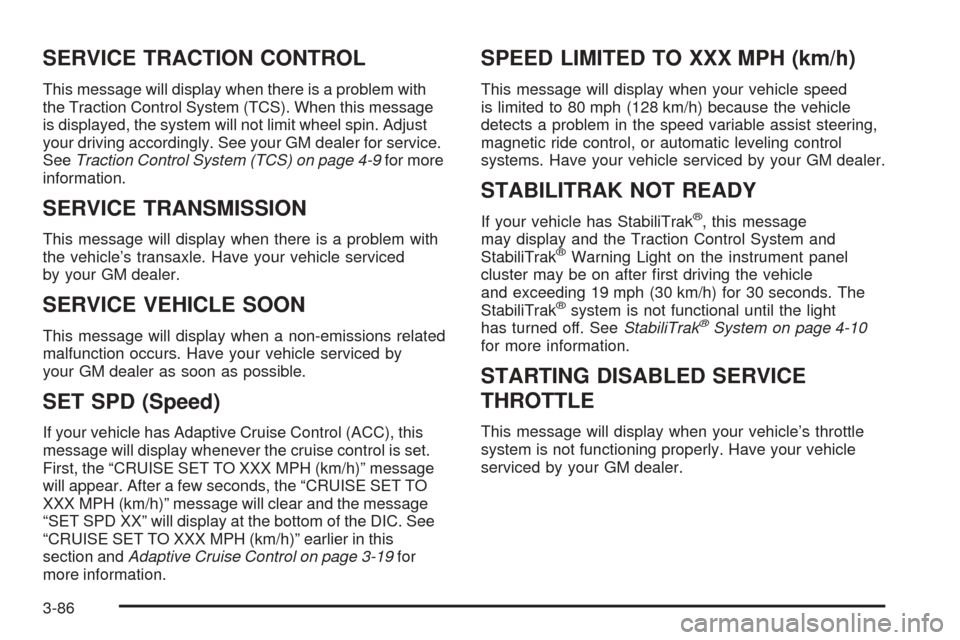
SERVICE TRACTION CONTROL
This message will display when there is a problem with
the Traction Control System (TCS). When this message
is displayed, the system will not limit wheel spin. Adjust
your driving accordingly. See your GM dealer for service.
SeeTraction Control System (TCS) on page 4-9for more
information.
SERVICE TRANSMISSION
This message will display when there is a problem with
the vehicle’s transaxle. Have your vehicle serviced
by your GM dealer.
SERVICE VEHICLE SOON
This message will display when a non-emissions related
malfunction occurs. Have your vehicle serviced by
your GM dealer as soon as possible.
SET SPD (Speed)
If your vehicle has Adaptive Cruise Control (ACC), this
message will display whenever the cruise control is set.
First, the “CRUISE SET TO XXX MPH (km/h)” message
will appear. After a few seconds, the “CRUISE SET TO
XXX MPH (km/h)” message will clear and the message
“SET SPD XX” will display at the bottom of the DIC. See
“CRUISE SET TO XXX MPH (km/h)” earlier in this
section andAdaptive Cruise Control on page 3-19for
more information.
SPEED LIMITED TO XXX MPH (km/h)
This message will display when your vehicle speed
is limited to 80 mph (128 km/h) because the vehicle
detects a problem in the speed variable assist steering,
magnetic ride control, or automatic leveling control
systems. Have your vehicle serviced by your GM dealer.
STABILITRAK NOT READY
If your vehicle has StabiliTrak®, this message
may display and the Traction Control System and
StabiliTrak
®Warning Light on the instrument panel
cluster may be on after �rst driving the vehicle
and exceeding 19 mph (30 km/h) for 30 seconds. The
StabiliTrak
®system is not functional until the light
has turned off. SeeStabiliTrak®System on page 4-10
for more information.
STARTING DISABLED SERVICE
THROTTLE
This message will display when your vehicle’s throttle
system is not functioning properly. Have your vehicle
serviced by your GM dealer.
3-86
Page 219 of 450

THEFT ATTEMPTED
This symbol appears with
this message.
This message will display if the content theft-deterrent
system has detected a break-in attempt while you
were away from your vehicle. SeeContent
Theft-Deterrent on page 2-19for more information.
TIGHTEN GAS CAP
This message will display when the gas cap has not
been fully tightened. Recheck the gas cap to ensure that
it is on and tightened properly.
TIRE LEARNING ACTIVE
If your vehicle has a Tire Pressure Monitor (TPM)
system, this message will display when the system is
re-learning the tire positions on your vehicle. See
Tire Pressure Monitor System on page 5-59. The tire
positions must be re-learned after rotating the tires
or after replacing a tire or sensor. SeeTire Inspection
and Rotation on page 5-63andIn�ation - Tire Pressure
on page 5-56for more information.
TRACTION CONTROL OFF
This message will display when the traction control
system is turned off. Adjust your driving accordingly.
SeeTraction Control System (TCS) on page 4-9
for more information.
TRACTION CONTROL ON
This message will display when the Traction Control
System (TCS) is turned on. SeeTraction Control System
(TCS) on page 4-9for more information.
TRANSMISSION HOT IDLE ENGINE
This message will display when the transaxle �uid in
your vehicle is too hot. Stop the vehicle and allow it to
idle until the transaxle cools down or until this
message is removed.
3-87
Page 229 of 450

Audio System(s)
Determine which radio your vehicle has and then
read the pages following to familiarize yourself with
its features.
Driving without distraction is a necessity for a safer
driving experience. SeeDefensive Driving on page 4-2.
By taking a few moments to read this manual and
get familiar with your vehicle’s audio system, you can
use it with less effort, as well as take advantage of
its features. While your vehicle is parked, set up your
audio system by presetting your favorite radio stations,
setting the tone, and adjusting the speakers. Then,
when driving conditions permit, you can tune to
your favorite stations using the presets and
steering wheel controls if the vehicle has them.{CAUTION:
This system provides you with a far greater
access to audio stations and song listings.
Giving extended attention to entertainment
tasks while driving can cause a crash and you
or others can be injured or killed. Always keep
your eyes on the road and your mind on the
drive — avoid engaging in extended searching
while driving.
Keeping your mind on the drive is important for safe
driving. For more information, seeDefensive Driving
on page 4-2.
3-97
Page 230 of 450
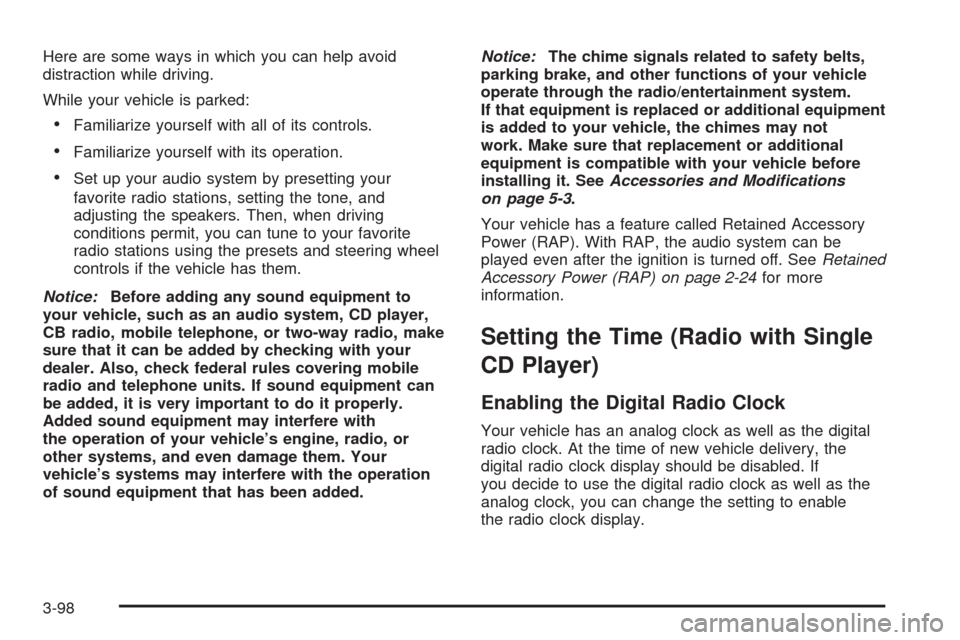
Here are some ways in which you can help avoid
distraction while driving.
While your vehicle is parked:
Familiarize yourself with all of its controls.
Familiarize yourself with its operation.
Set up your audio system by presetting your
favorite radio stations, setting the tone, and
adjusting the speakers. Then, when driving
conditions permit, you can tune to your favorite
radio stations using the presets and steering wheel
controls if the vehicle has them.
Notice:Before adding any sound equipment to
your vehicle, such as an audio system, CD player,
CB radio, mobile telephone, or two-way radio, make
sure that it can be added by checking with your
dealer. Also, check federal rules covering mobile
radio and telephone units. If sound equipment can
be added, it is very important to do it properly.
Added sound equipment may interfere with
the operation of your vehicle’s engine, radio, or
other systems, and even damage them. Your
vehicle’s systems may interfere with the operation
of sound equipment that has been added.Notice:The chime signals related to safety belts,
parking brake, and other functions of your vehicle
operate through the radio/entertainment system.
If that equipment is replaced or additional equipment
is added to your vehicle, the chimes may not
work. Make sure that replacement or additional
equipment is compatible with your vehicle before
installing it. SeeAccessories and Modifications
on page 5-3.
Your vehicle has a feature called Retained Accessory
Power (RAP). With RAP, the audio system can be
played even after the ignition is turned off. SeeRetained
Accessory Power (RAP) on page 2-24for more
information.
Setting the Time (Radio with Single
CD Player)
Enabling the Digital Radio Clock
Your vehicle has an analog clock as well as the digital
radio clock. At the time of new vehicle delivery, the
digital radio clock display should be disabled. If
you decide to use the digital radio clock as well as the
analog clock, you can change the setting to enable
the radio clock display.
3-98